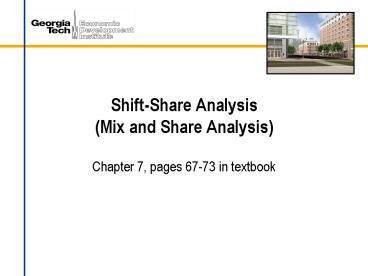Shift-Share Analysis (Mix and Share Analysis) - PowerPoint PPT Presentation
1 / 25
Title:
Shift-Share Analysis (Mix and Share Analysis)
Description:
Shift-Share Analysis (Mix and Share Analysis) Chapter 7, pages 67-73 in textbook What is Shift-Share Analysis? One way to account for a region s competitiveness ... – PowerPoint PPT presentation
Number of Views:118
Avg rating:3.0/5.0
Title: Shift-Share Analysis (Mix and Share Analysis)
1
Shift-Share Analysis (Mix and Share Analysis)
- Chapter 7, pages 67-73 in textbook
2
What is Shift-Share Analysis?
- One way to account for a regions competitiveness
- Provides a picture of how well a regions mix of
industries is performing - Also, shows how well individual industries are
doing - Can be used to analyze individual industries or
the whole economy
3
What is Shift-Share Analysis?
- Breaks down regional employment growth into three
components - National share (NS)
- Industry mix (IM)
- Regional shift (RS)
4
What is Shift-Share Analysis?
- National Share (NS) Component
- Share of regional job growth attributable to
growth of the national economy - If the regional industry grew at the industrys
national growth rate, what would be the result?
Where t current time period t-1 one year
ago i specific industry r specific region
5
What is Shift-Share Analysis?
- Industry Mix (IM) Component
- How much growth can be attributed to the regions
mix of industries? - Also estimates how many jobs were created/not
created in each industry due to differences in
industry and total national growth rates
Where t current time period t-1 one year
ago i specific industry r specific region
6
What is Shift-Share Analysis?
- Regional Shift (RS) Component
- How many jobs are created/not created as a result
of the regions competitiveness? - Perhaps the most important component
- Identifies the regions leading and lagging
industries
Where t current time period t-1 one year
ago i specific industry r specific region
7
A Shift-Share Example
- Compare a county to the U.S. economy.
- Well use 1993 and 1998 with total employment
divided into six sectors. - Rule of thumb is to use two time periods 5 or
fewer years apart. - Analysis can be quite different for different
time periods.
8
A Shift-Share Example
- National total employment and by major industry
sector, 1993 1998.
9
A Shift-Share Example
- Calculate the percentage change in U.S. total
employment and by industry sector.
10
A Shift-Share Example
- County total employment and by major industry
sector, 1993 1998.
11
A Shift-Share Example
- Calculate the percentage change in the countys
total employment and by industry sector.
12
A Shift-Share Example
- Calculating the NS component.
13
A Shift-Share Example
- Calculating the NS component.
14
A Shift-Share Example
- If the countys industries grew at the overall
national rate of growth new job growth would have
been 32,492 between 1993 and 1998.
Ex 7,951 ((160,199,000/141,996,000)-1) 1,019
15
A Shift-Share Example
- Calculating the IM component.
16
A Shift-Share Example
- Calculating the IM component.
17
A Shift-Share Example
- Calculating the IM component.
18
A Shift-Share Example
- The industrial mix component of 2,737 means that
the county has nearly 2,800 fewer jobs than it
would have had if its structure were identical to
the nations.
Ex 7,951 ((3,127/3,130)-1)
((160,199/141,996)-1)) -1,027
19
A Shift-Share Example
- Calculating the RS component.
20
A Shift-Share Example
- Calculating the RS component.
21
A Shift-Share Example
- Calculating the RS component.
22
A Shift-Share Example
- The regional shift component shows that 199 new
jobs in the county are attributable to its
relative competitive position. This is primarily
due to its high-growth of service employment.
Ex 7,951 (((7,977/7,951)-1) -
((3,127/3,130)-1)) 34
23
A Shift-Share Example
- Adding it all up
- Make sure your math is correct by adding the
three components. - They should total the actual change in employment
for the region
Eir IMtir NStir RStir
24
Shift Share Lab
- Calculate NS, IM, and RS for each industry and
make sure that total employment change in the
region is equal to the sum of the three total
components. - Identify the SICs with positive IM and RS values
and among those, which ones have RSgtIM.
25
(No Transcript)

